Digital Marketing Attribution For Beginners: How To Get Started With Campaign Attribution

Picture this: You've been asked to create a multi-channel marketing strategy to improve brand awareness and sales for a client's e-commerce store.
Besides identifying goals and key performance indicators (KPIs), you should also determine how you'll evaluate which marketing activities are working and which are not.
Answering these questions is where marketing attribution comes in. Using it well, you can determine where to allocate your time and effort to marketing touchpoints that contribute to campaign goals. These touchpoints can include various marketing activities, such as pay-per-click (PPC) ads, blog posts, email newsletters, and more.
If you’re unsure about attribution, this guide will explain the basics of digital marketing attribution, explain why it’s worth investing time in understanding attribution, and show you how to combine it all in a report using DashThis.
- What is attribution in digital marketing?
- 6 types of attribution models to analyze your marketing results with
- Benefits of creating campaign attribution reports
- How to use DashThis to create your multi-channel attribution report
- Automate your multi-channel reporting with DashThis
What is attribution in digital marketing?
Digital marketing attribution is about giving your marketing efforts the credit they deserve for their role in driving marketing results and conversions according to a set of rules. Typically, companies do this by using a predefined attribution model or creating their own.
Why is this necessary? Think about how you make a buying decision nowadays.
For example, say you’re considering reporting automation and first encounter DashThis through an organic search. While creating a client report, you land on one of DashThis’s resources, which helps you understand a KPI definition.
Two weeks later, you see DashThis’s Google display ad on a website directing them to sign up for a newsletter.
Weeks pass, and you’ve continued engaging with DashThis’s newsletter. There’s an upcoming internal meeting to discuss client reporting measures, so now’s a good time to evaluate possible reporting solutions. You go directly to the website to sign up for free trials to test different solutions, including DashThis.
Here, what contributed to your decision to test out the free trial?
Was it the blog content, the Google display ad, or the newsletter? You'll answer the question differently depending on the attribution model you use.
When you implement marketing attribution, you take the attribution data from your marketing campaigns and analyze it using a model to determine what’s driving conversions or helping to meet your campaign goals at a particular stage in the sales cycle.
Different attribution models are better suited for companies with varying needs. For example, first-touch attribution is a simpler marketing attribution model for evaluating the effectiveness of brand awareness initiatives. In contrast, multi-touch attribution analyzes conversion credit along various touchpoints of the entire user journey.
With the suitable attribution model in place, you can confidently understand which campaigns work best in your marketing mix and which campaigns have the highest return on investment (ROI) for your clients. All these efforts help you focus on the marketing activities that deliver results.
6 types of attribution models to analyze your marketing results with
1. First-touch attribution
- What it is: Conversion credit goes to the first touchpoint (usually a top-of-funnel touchpoint) before a conversion
- Pros: Easy to set up and understand. Tracks what campaign or channel customers engage with first
- Cons: First-click attribution can overestimate the ROI of your top-of-the-funnel efforts
- Who should use it: Single-touch attribution models suit companies with shorter sales cycles that need a simple attribution model to start or if you want to understand the effectiveness of your brand awareness efforts
- Example KPIs: Website traffic by marketing channel, page views, new conversion rate of first-touch leads, cost per first-touch lead acquisition
2. Last-touch attribution
- What it is: Conversion credit goes to the last interaction (usually a bottom-of-funnel touchpoint) before a conversion
- Pros: Easy to set up and understand. Focuses on the interaction which converts sales opportunities into paying customers
- Cons: Last-click attribution can overestimate the ROI of a last touchpoint like an email call-to-action
- Who should use it: Companies with a longer sales cycle that need a simple attribution model to start or if you’re focusing on improving conversion rate or lead generation
- Example KPIs: Conversion rate per marketing channel, cost per last-touch conversion, conversion rate of last-touch interactions
3. Linear attribution model
- What is it: Assigns equal conversion credit across every touchpoint in a customer journey leading up to a conversion or sale. Also known as the W-shaped attribution model.
- Pros: Simple model to get started with multi-attribution. Analyzes how customers interact with your brand before they buy
- Cons: May not give an accurate picture of marketing effectiveness. For example, an email click and a free trial sign-up get the same conversion credit, even though the free trial is more valuable to a business.
- Who should use it: Companies who need a basic introduction to multi-attribution models or a customer journey overview
- Example KPIs: Number of touchpoints per converting customer, average conversion rate across all touchpoints
4. Time-decay attribution model
- What it is: Marketing touchpoints closer to a sale or conversion get more credit for conversions
- Pros: Assesses the most influential touchpoints during the final stages of a purchase journey
- Cons: Can over-emphasize bottom-of-the-funnel efforts
- Who should use it: Companies with longer sales cycles that want to understand which channels are most effective at driving conversions
- Example KPIs: Customer lifetime value (CLV) by acquisition channel, Return on ad spend (ROAS) by channel
5. Position-based attribution
- What it does: It assigns more conversion credit to the first and last touchpoints, while distributing the rest among the other marketing touchpoints. Also known as U-shaped attribution.
- Pros: Accessible way to start with multi-touch attribution
- Cons: Focuses on top and bottom-of-the-funnel activities at the expense of the touchpoints that help build credibility and awareness, like social media content or content marketing
- Who should use it: Marketing teams who want to optimize their top or bottom-of-the-funnel channels
- Example KPIs: Conversion rate by marketing channel, brand awareness, customer acquisition cost
6. Custom attribution model
- What it is: An attribution model built in-house for an organization
- Pros: Can customize marketing attribution to fit your marketing team’s specific needs or meet a desired outcome
- Cons: Can be expensive and time-consuming to create and maintain
- Who should use it: Companies with complex and longer sales cycles
- Example KPIs: Customer lifetime value (CLV) by acquisition channel, Return on ad spend (ROAS) by channel
Benefits of creating campaign attribution reports
Identify the most effective marketing channels and campaigns
Before making a purchase or signing up for a sales call, users may visit a website multiple times from different channels or devices over a period of time. To track multi-channel marketing performance properly, you must understand how each marketing channel contributed to a conversion.
Companies like Uber recognize the need for multi-channel attribution. It uses an in-house marketing multi-attribution model to determine which marketing channels to focus on in its marketing strategy.
“When a user sees a social network ad, then searches “Uber” on the web, clicks a search ad, and later signs up with Uber, it’s not fair to give all the credit to the search ad. Multi-touch attribution involves looking at the impression level data, analyzing the complete user conversion journey, and then attributing the right weight of credit for each conversion to multiple channels.”
Proper attribution is vital to marketing success. It allows you to make smarter marketing decisions. You’ll know which marketing touchpoints users interact with along their buyer journey, how much each channel contributed to a conversion, and how to reallocate your resources for the best results.
Optimize marketing performance
Digital marketing attribution helps you uncover underperforming marketing channels and campaigns with a data-driven approach. It also allows you to focus on the campaigns that meet your campaign goals or help with campaign optimization.
A simple example of an attribution report is the Google Analytics campaigns and traffic sources report. This GA4 attribution tool tells you where your website traffic comes from while assigning conversion credit to the ads and interactions that lead a user to your website.
Measure and prove marketing ROI
Attribution helps you create and manage more effective campaigns and communicate marketing results to your clients.
Let’s say you’re reviewing your latest marketing results with your client. Your client asks if their Instagram ad campaign, Google Ads, or email marketing is more effective at driving sales for their e-commerce store this month.
With detailed information on leads generated across channels, budget spent, and a complete picture of which marketing touchpoints contributed more to a conversion or sale, you have the data you need to prove the effectiveness of your marketing efforts and make informed decisions for your clients and their stakeholders.
Integrating a Customer Data Platform enhances this process by providing a unified view of all customer data, which is essential for precise marketing attribution and campaign strategy optimization. This comprehensive data integration allows you to assess and attribute the real impact of each channel on your ROI, ensuring your strategies are data-driven and client-focused.
How to use DashThis to create your multi-channel attribution report
Managing marketing attribution across multiple channels involves a lot of data. It’s tedious and time-consuming to assemble, but reports can quickly get overwhelming if you manually export and input your data across multiple platforms into an Excel spreadsheet.
Thankfully, reporting software like DashThis can help. Here’s a step-by-step guide on creating and sharing a multi-channel attribution report in DashThis with your clients.
Step 1: Select a template
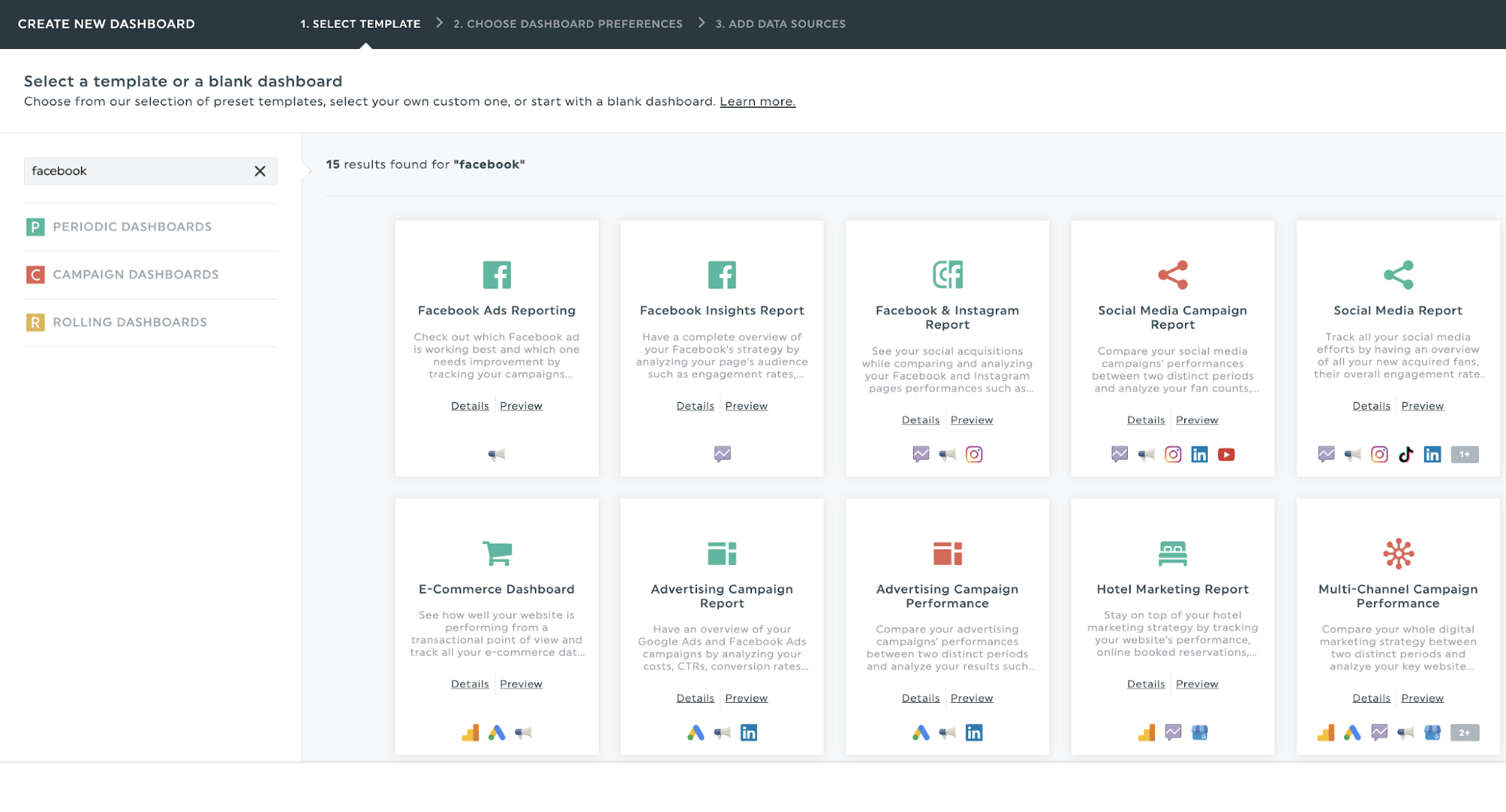
You can start with one of DashThis’s dashboard templates or use our digital marketing report template to create a new dashboard from scratch.
Step 2: Connect your marketing data sources
Say goodbye to painful data exports and formatting and hello to easily understandable aggregated data in one report. DashThis integrates with over 34 marketing tools, so simply add the data sources you’re reporting on with the Connect button.
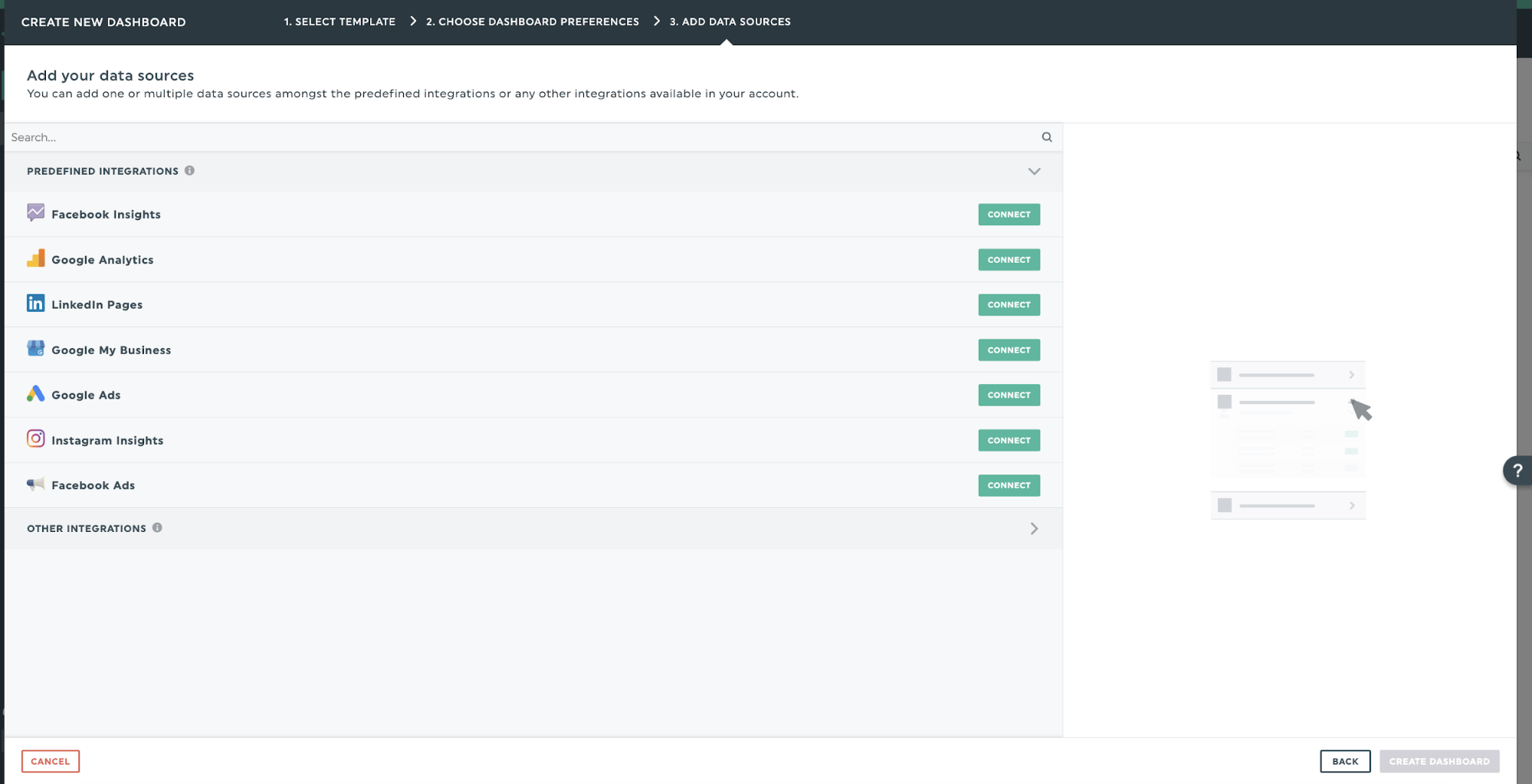
As soon as you permit DashThis to access your marketing data in each tool, DashThis will automatically import your latest data from your selected channels and keep your reports current.
Step 3: Choose relevant KPIs and customize your report layout
DashThis’s drag-and-drop interface makes choosing the metrics you’re reporting on easy. Use headers and sections to organize your KPIs into a logical, easy-to-follow flow for your client or stakeholder to review.
For example, if you’re creating a multi-channel attribution report analyzing the number of conversions across LinkedIn, YouTube metrics, and email marketing, you could group metrics for each channel with headers to make your report more straightforward. Compare common KPIs across multiple channels to help you know which initiatives drive the most conversions, traffic, or revenue.
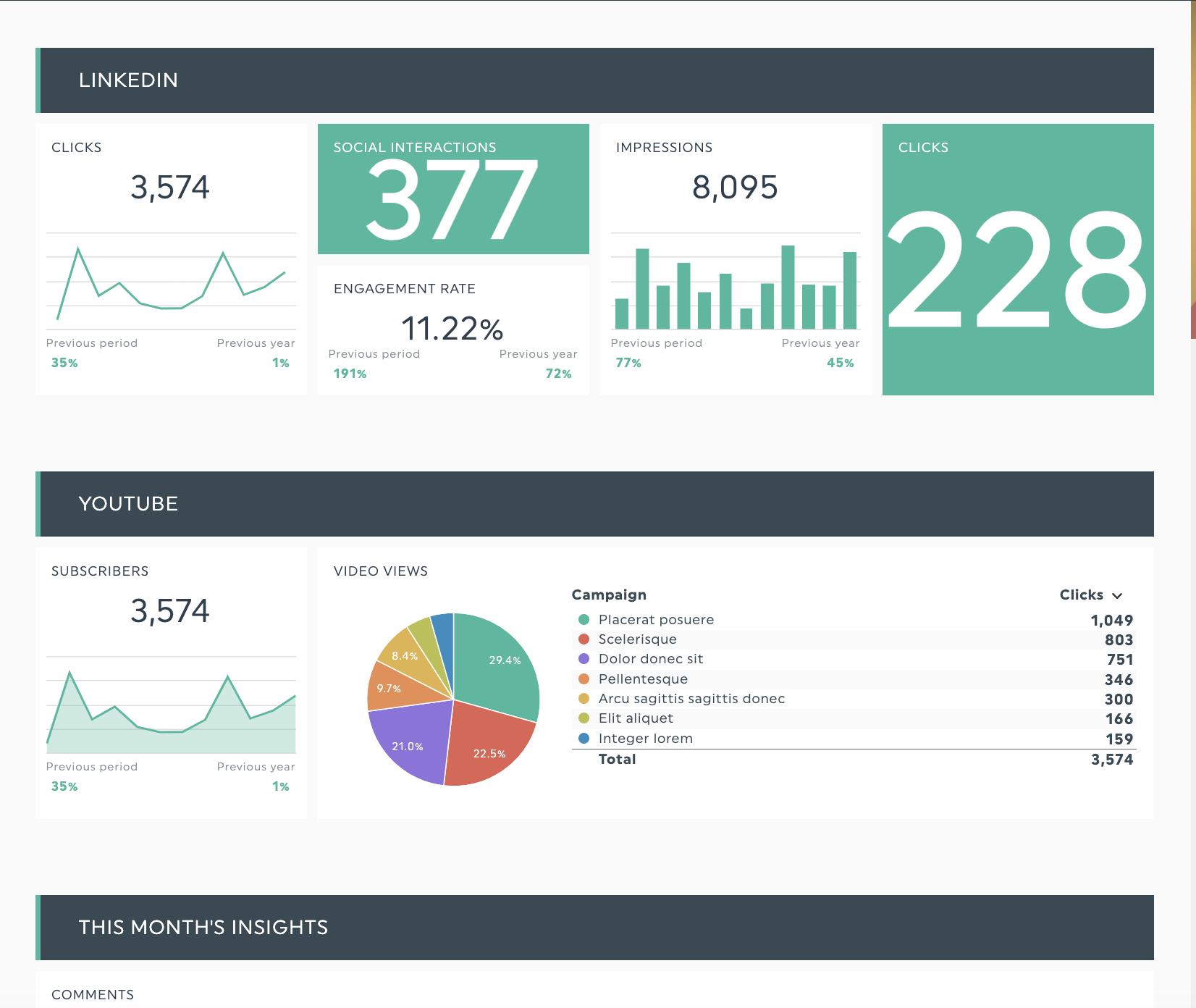
Get this social media report template with your own data!
Step 4: Share your attribution report with your clients
Once you’re happy with the way your report looks, use DashThis’s reporting scheduling options to save even more time. Click Sharing Options > Share by Email > Frequency to schedule your reports.
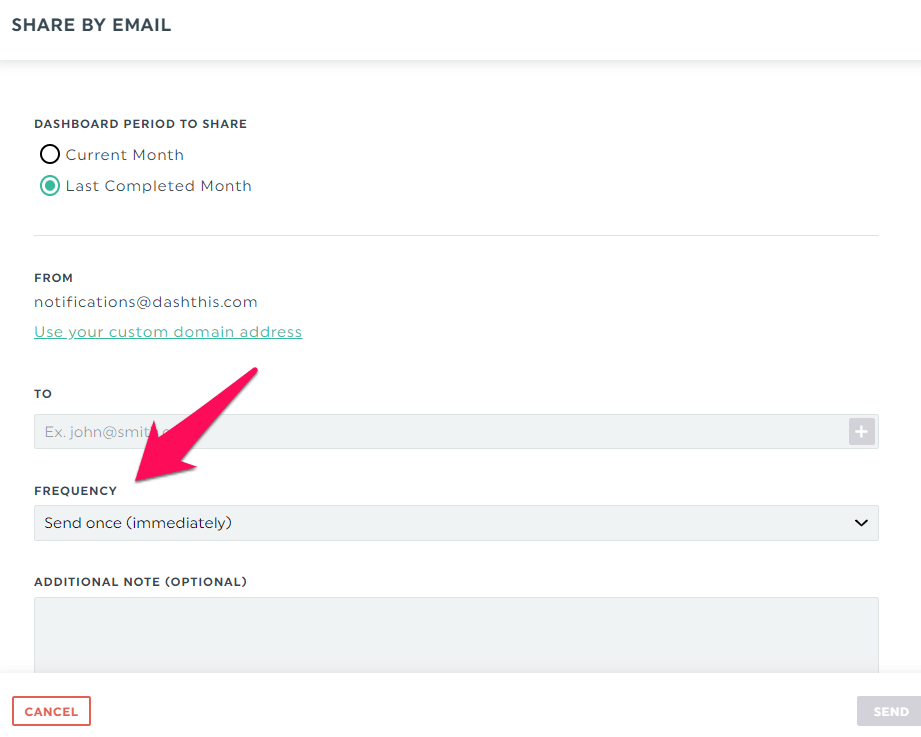
This automatic email dispatch feature lets you set it once, daily, weekly, monthly, or quarterly. DashThis will automatically schedule and send the report according to your chosen time frame.
Alternatively, download your report as a PDF or share a URL link so clients can view it online in real time—perfect if you’re preparing for an in-person or video conferencing meeting to discuss your client’s latest results.
Make attribution easier with a digital marketing report template
Get a better understanding of your marketing efforts with DashThis's report template. It’s designed to report and visualize metrics from multiple marketing channels, For example, you can combine an in-depth SEO report with an attribution path report from Google Analytics 4 to understand the value of SEO in boosting conversions.
Use DashThis’s array of marketing data visualizations to identify patterns, communicate recommendations to clients, and give them reports that are easy to digest and share with their team. Investing in transparent reporting is a win-win: you communicate the value of your work clearly, and your clients get a report that’s easy to digest and share with their team.
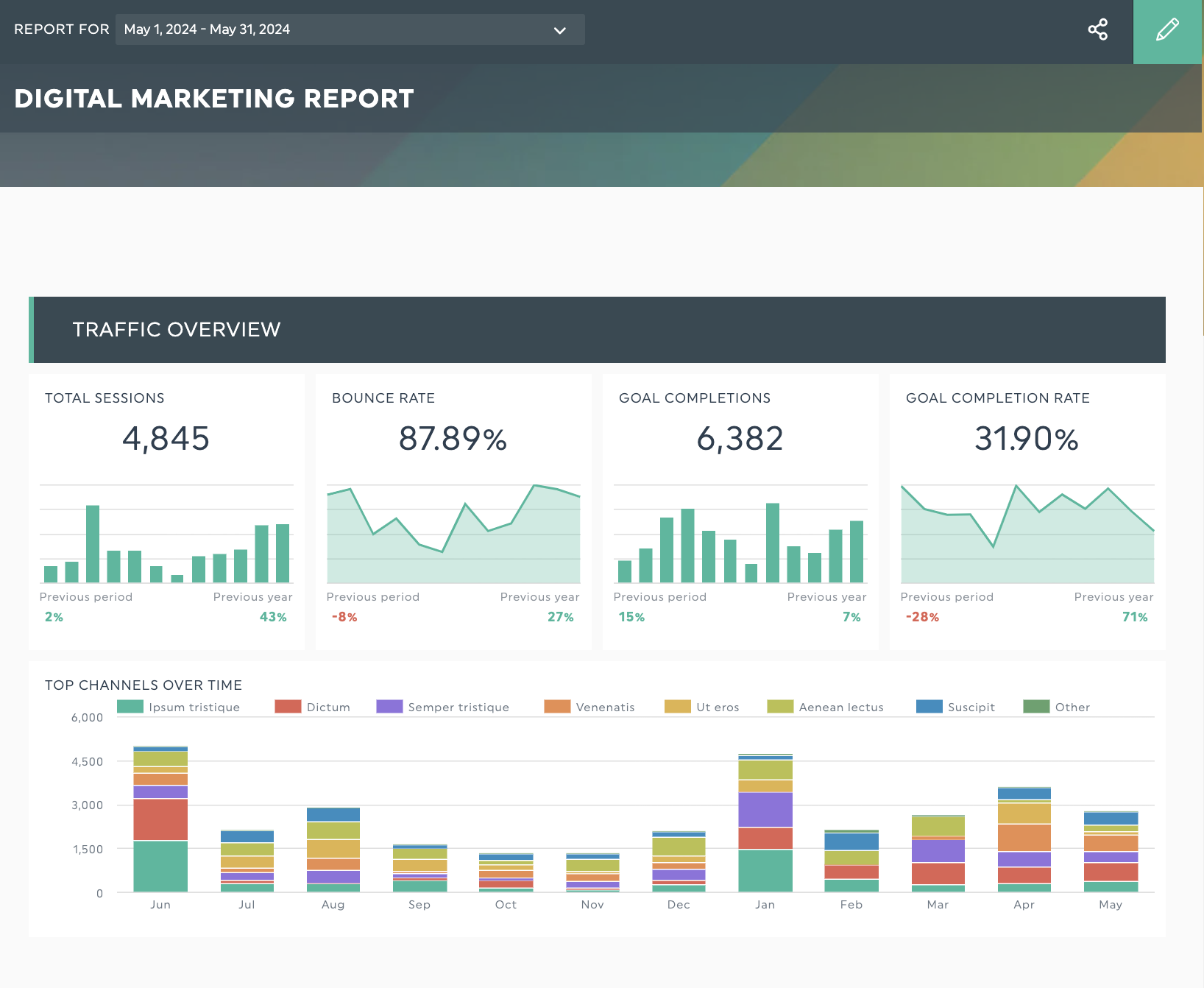
Get this digital marketing report template with your own data!
Automate your multi-channel reporting with DashThis
Marketing attribution can be tricky to get right and communicate, but it’s the key to accurately reporting client results and effectiveness. Getting attribution right ensures your campaign recommendations and tweaks remain trustworthy and based on actual marketing data.
Take back your valuable time with report automation. Sign up for your free 15-day trial of DashThis today.
Track your marketing data with Dashthis today!
Read More
Don’t miss out!
Automate your reports!
Bring all your marketing data into one automated report.
Try dashthis for free

